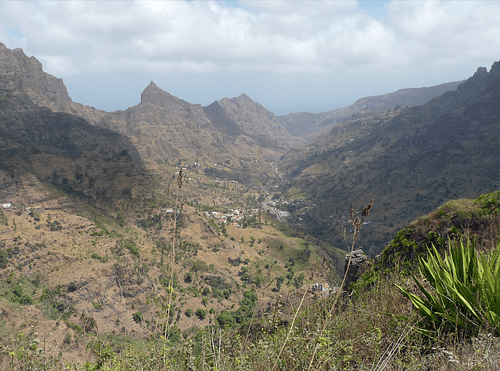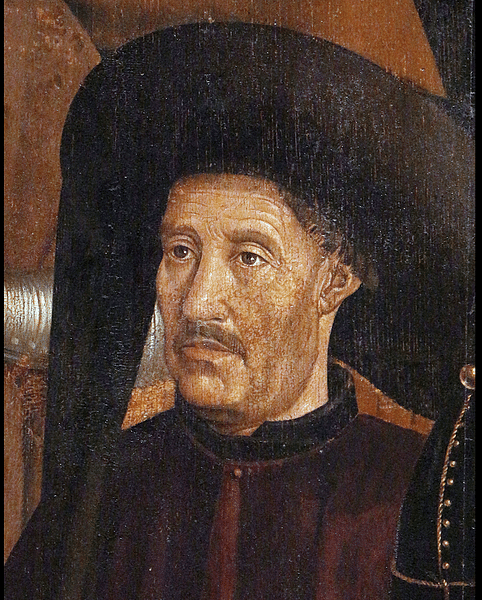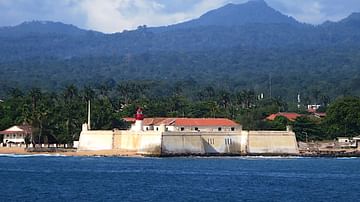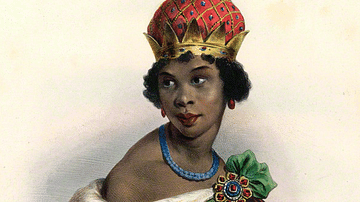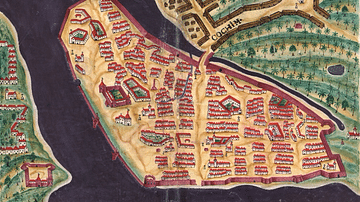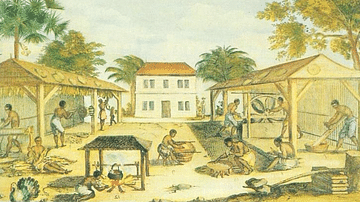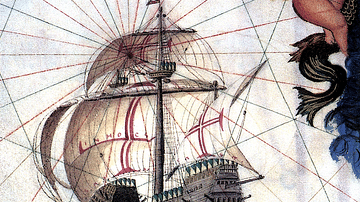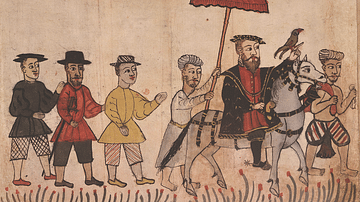The Portuguese colonization of the Cape Verde (Cabo Verde) Islands began from 1462. Initially envisaged as a base to give mariners direct access to West African trade, the Central Atlantic islands soon became a major hub of the Atlantic slave trade. Slaves were used on the sugar plantations of the islands and sold on to ships sailing to the Americas.
Unlike the other Atlantic islands under Portuguese control, the Cape Verde group was subject to arid winds and irregular rainfall, which made life there precarious. Given trading concessions for the African coast, Cape Verdeans did manage to make their agriculture sustainable, and their cotton textiles, in particular, were in great demand on the mainland. Cape Verde was strategically important as a base for resupply for ships sailing to and from Portuguese territories in the East Indies and Brazil. The islands sent African slaves across the Atlantic and used them to such a degree in the Cape Verde archipelago that eventually the population became racially mixed with few cultural ties to Europe by the 17th century. The islands gained independence from Portugal in 1975.
Geography & Climate
Located some 500 kilometres (310 mi) off the coast of West Africa (Mauritania and Senegal), the Cape Verde island group is named after the westernmost cape of the African continent. There are nine inhabited islands today, the capital being Praia on Santiago (São Tiago). The most important port is Mindelo on São Vicente. The other islands are Boa Vista, Brava, Fogo, Maio, Santo Antão, São Nicolau, and Sal. Santa Luzia is an uninhabited island, and there are several islets.
The islands are varied in topography, with some being relatively flat and others mountainous. Pico is an active volcano on Fogo and the highest point in the group at 2,829 metres (9,281 ft). The islands are divided into two groups: the Windward (Barlavento) and Leeward (Sotavento), names which indicate the strong winds which can blow in from across the Atlantic.
The islands are not blessed with abundant water sources and rainfall is irregular, although often torrential when it does come. The soil is shallow but rich thanks to the volcanic origins of the islands. The climate is usually moderate, but the arid winds meant wheat, vines, and olives could not be grown as on other Portuguese territories. There were few meat sources on the island, the only indigenous mammal being bats. One source of meat was the sea turtles which nest on some of the islets.
Discovery
It is likely that Cape Verde was known to ancient mariners such as the Phoenicians, and to Islamic sailors and Africans. However, it was not until the 15th century that anyone took a serious interest in populating the islands. Two Genoese mariners, sailing under the flag of Portugal, discovered the archipelago in 1460. Their names were Antonio and Bartolomeo da Noli.
The Portuguese Crown was keen to gain direct access to the gold of West Africa and the Cape Verde islands provided a handy means by which they could sail down the coast and avoid the Islamic states in North Africa who were themselves intent on monopolising African trade. The first major obstacle was a geographical one: how to sail around Cape Bojador and be able to make it back to Europe against the prevailing north winds? The answers were better ship design - caravels using lateen sails - and a bold course setting out away from the African coastline and using winds, currents, and high-pressure areas to sail back home.
Prince Henry the Navigator (aka Infante Dom Henrique, 1394-1460) had sponsored expeditions of discovery that led to the Portuguese colonization of Madeira (1420) and the Azores (1439). These islands proved useful stepping stones for mariners intent on expeditions of discovery further south. In 1462, it was the turn of Cape Verde to be added to Portugal’s maritime and agricultural assets.
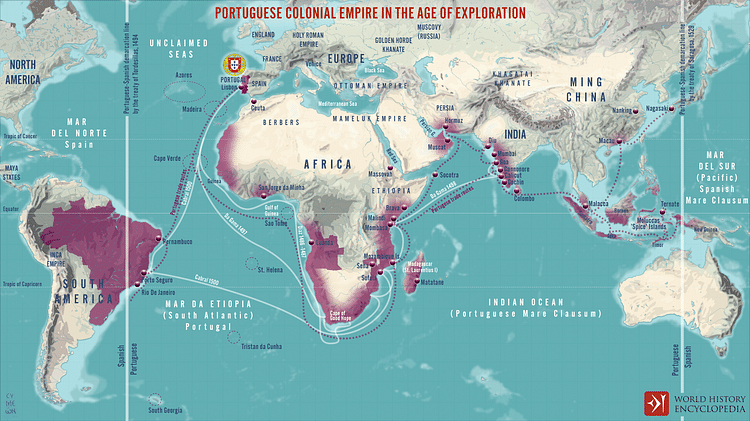
In 1462 Portuguese settlers arrived on Santiago and founded Ribeira Grande, which would be the capital for the next 250 years. Initially, the islands were granted to Prince Fernando, nephew and heir of Prince Henry, but in 1495, they returned to the full control of the monarch, then King Manuel I of Portugal (r. 1495-1521).
While West Africa was, for the moment, Portugal’s to monopolize, there were some squabbles with Spain over the Atlantic islands, particularly over who should have possession of the Canary and Cape Verde Islands. The 1479-80 Treaty of Alcáçovas-Toledo set out that the Canaries were Spain’s domain while Portugal controlled the Cape Verdes, Azores, and Madeiras. There were also some additional vague clauses to the treaty that would cause trouble later such as Portugal’s right to future discoveries in Africa and Spain’s to islands beyond the Canaries, interests which were eventually identified as the Caribbean and even the Americas.
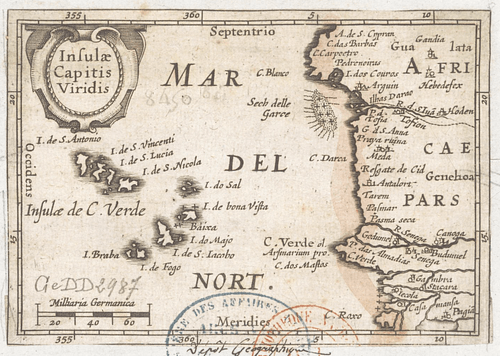
Settlement
As with the Portuguese colonization of the Azores and Madeira, the Crown partitioned the islands and gave out 'captaincies' (donatarias) as part of the system of feudalism to encourage nobles to fund their development. The first 'captain' of Santiago was Antonio da Noli. Each 'captain' or donatario was given the responsibility of settling and developing their area in return for financial and judicial privileges, Accordingly, 'captains', in turn, distributed parts of their estates to their followers for development, parcels of land known as semarias. Men given such land had the responsibility of clearing it and beginning cultivation within a set period. The captaincies became hereditary offices in many cases. The model of donatarias would be applied to other Portuguese colonial territories in the future, notably in Brazil.
Settlers were a mix of mostly Portuguese (particularly from the Azores and the Algarve region of Portugal), some Jewish migrants seeking religious freedom, undesirables from Portugal such as deportees, and a number of Italians and French. Later, English and African settlers came, too.
As with the Portuguese colonization of Madeira and the Azores, sugar cane was planted with high hopes. However, the aridity of the islands limited yields. Droughts and famine were not infrequent due to the highly irregular rainfall. Settlers introduced such animals as goats and cattle, and forests were cut down to make way for agriculture, much to the detriment of the soil in the long term. Besides sugar, products of the Cape Verde islands included a red dye from the lichen orchil, salt deposits (on Maio, Sal, and Boa Vista), grains and roots of African origin, maize introduced from the Americas, manioc, and sweet potatoes. Horses were reared on Santiago in the 15th century which were then shipped to the African coast. The cotton textiles produced on the islands were in great demand on the mainland coast and were designed specifically for that market using traditional African patterns. There was, too, a specific Cape Verdean design - six stripes of white, black, and blue - and cloth strips of this design were even used as a form of currency on the islands.
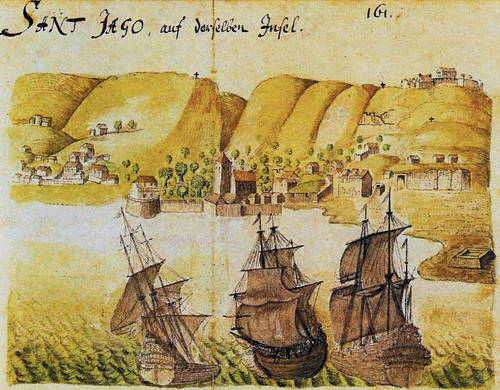
The Portuguese Crown had granted Cape Verdeans the right to trade with the African coastal communities in 1466, and they were given tax exemptions. There were some conditions such as only residents who had been on the islands for four years could trade and they could only do so with goods from the Cape Verde islands. These favours were likely granted because the agriculture on the island was not dependable. The arrangement meant that Portuguese trade settlements were established on the continent, which could take advantage of the well-organised African trade that saw goods travel from the interior along the major rivers (e.g. Gambia and Senegal) to the coast. Goods acquired included gold, slaves, ivory, pepper, beeswax, gum, and dyewoods. At this stage, the Portuguese made no attempt at conquest since they lacked the manpower and it was, in any case, unnecessary since the existing trade networks were so well-established and organised. Sometimes fortifications were built to protect trade centres, but these were always constructed with permission from the local chiefs. The good trade relations between the islands and coast brought other advantages such as the possibility to lease land for cultivation when there were poor harvests on the islands and for the Cape Verdeans to offer refuge to exiles during tribal warfare on the mainland.
The islands continued to be of strategic value to mariners. Vasco da Gama’s historic voyage around the Cape of Good Hope to India in 1497-8 stopped off at the islands. Ferdinand Magellan’s epic expedition also called in for resupply at the Cape Verde Islands during the first circumnavigation of the globe in 1519-22.
Slavery
The islands really gained wider prominence when the slave trade to the Americas took off. Cape Verde was ideally located to ship slaves from the African continent and then put them aboard the slave ships that crossed the Atlantic to be used as labour in plantations in the Caribbean, North America, and Brazil. On the return journey, these ships brought back trade goods which were then marketed through Cape Verde and on to Africa and Europe.
Slaves also worked on the sugar and cotton plantations on the Cape Verde Islands and in the industry producing indigo die. All three products were exported, along with island-made fabrics, to the African mainland and exchanged for slaves, which were then shipped to the Americas. Slaves were given a number of basic lessons in Portuguese and Christianity, both of which made them more valuable if they ever made it to the Americas. These lessons also eased traders’ consciences that they were somehow benefitting the slaves and giving them the opportunity of what they considered eternal salvation. Around 3,000 slaves a year took the terrible and often deadly voyage across the Atlantic. Many free Cape Vedereans went, too, attracted by the possibilities of Portugal’s new presence in Brazil.
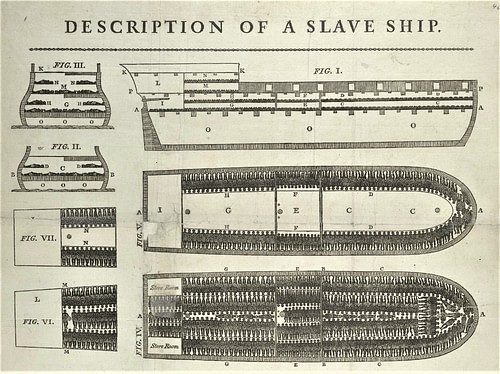
The Florentine merchant and slaver Francesco Carletti visited the Cape Verde Islands in 1594. He gives the following vivid description of the slave trade on Santiago:
…we bought seventy-five slaves, two-thirds men and one-third women, both young and old, large and small. All were mixed together according to the custom of the country in a flock, just as in our country we would buy sheep, having first taken all the necessary precautions to make sure that they were in good health, had good constitutions and had no bodily defects. Each owner then marks them, or to say it more appropriately, brands them with his own brand mark. This is made of silver and is heated in the flame of a candle made of tallow with which the burn is anointed. The mark is made on the breast, or the arm or the back so that they be recognised.
…The slaves were embarked in the ship we had hired, the men below decks pressed and squeezed together one against the other in such a way that they had great difficulty in turning from one side to the other when they wanted to. The women were lodged after their own fashion on deck wherever they could find room in the ship.
(Newitt, 156-8)
As Cape Verde was much further from Portugal than the other Atlantic colonies (about two weeks sailing), so the islands attracted fewer European settlers, especially women. As a consequence, Europeans and Africans intermarried on the islands, creating an Afro-Portuguese culture which had a strong African religious and artistic influence. It was very often these free mixed-race Cape Verdeans who settled in the trading posts on the coast of Africa.
Another cultural influence was from the Portuguese ships sailing from the East which stopped off at the islands on their way back to Europe. As the major junction between the Portuguese African, American, and Indian empires, the Cape Verdes were certainly a cultural melting pot. In addition, the number of resident slaves steadily increased to eventually greatly outnumber the free settlers. By 1582, the populations of Fogo and Santiago, still the two main islands, were made up of 1,600 whites and mixed-race mulattoes, 400 free blacks, and 13,700 slaves.
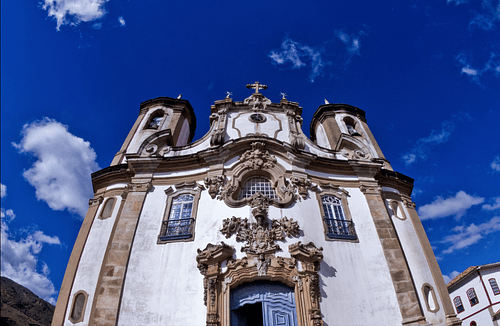
The wealth going through the islands and their strategic value inevitably attracted unwanted attention from other European powers, notably England and Spain, but also pirates of various nationalities. Pirates attacked the archipelago in 1541, and the English came in 1585 and 1592. The first English raid was led by Francis Drake (c. 1540-1596 CE) and resulted in the sacking of several settlements on Santiago. These latter raids had developed since Philip II of Spain (r. 1556-1598) had taken over Portugal in 1580 and so the Cape Verde Islands were seen as a legitimate target by Spain’s enemies. In 1598, a Dutch fleet attacked the islands as the international competition around West Africa became ever more intense. Trade routes also moved to the direct passage between Europe and West Africa so that the islands went into decline. A series of droughts throughout the 16th century further impoverished the islands. In 1712, the French pirate Jacques Cassard attacked the islands with the consequence that Praia became the capital in a gradual process not fully completed until 1770.
Later History
As the fortunes of the islands declined, many Cape Verdeans migrated to the Portuguese islands of São Tomé and Principe or to North America where the whaling industry offered employment. This was especially so with the end of the slave trade in 1876. The islands have always been strategically important and now they became useful as a refuelling base for steamships heading across the Atlantic and down the coast of Africa, even if the opening of the Suez Canal in 1869 meant that east-bound ships no longer had to go around the Cape of Good Hope. An important coaling station was developed for passing ships at Mindelo on São Vicente.
The various national groups on the islands intermarried early on in the island’s history and so the majority of today’s islanders are of mixed European and African descent, known as mestiço or Crioulo, which is also the name of the language spoken (with Portuguese still dominating in more formal contexts). Roman Catholicism remains the dominant religion, and the Iberian peninsula still dominates imports and exports. Cape Verde gained independence from Portugal in 1975 in a less tumultuous handover than was seen in Portuguese colonies on the African continent. The islands then became the Republic of Cabo Verde. Cidade Velha (formerly Ribeira Grande) on Santiago is listed by UNESCO as a World Heritage Site for its rich colonial architecture.
